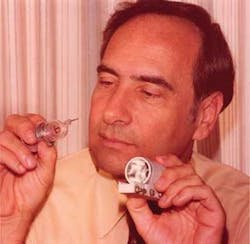OBITUARY: Theodore Maiman, 79, laser inventor, dies

May 16 marked the 47th anniversary of the invention of the first working laser. Good friends of its inventor, Theodore (Ted) H. Maiman, gathered on that day at Simon Fraser University (SFU; Burnaby, British Columbia, Canada) to celebrate the life and accomplishments of Maiman, who died on Saturday, May 5, just two months prior to what would have been his 80th birthday.
Andrew Rawicz, a professor in the School of Engineering Science at SFU, noted that the gathering was not a memorial service, but a celebration. “People like that never really die,” he said. “They live on with us through their accomplishments.”
The May 16th tribute also marked a first step in establishing a commemorative archive and scholarship funds for Maiman at SFU, where Maiman received one of his many honorary degrees and also served as an adjunct professor in the school of engineering, playing a key role in establishing a program in biomedical engineering and biophotonics.
Maiman was born in 1927 and raised in Denver, CO, where he learned electronics from his father, Abe, an electrical engineer for the American Telephone & Telegraph (AT&T). He began his academic studies at the University of Colorado and earned a bachelor-of-science degree in engineering physics in 1949. Two years later, he attended Stanford University where he earned a master’s degree in electrical engineering, followed by a doctorate in physics in 1955. At Stanford, Maiman studied under the theoretician Willis Lamb, who was awarded the Nobel Prize in physics in 1955, months after Maiman received his doctorate.
In 1960, Maiman invented the first functioning laser while working at Hughes Aircraft Company. His managers there had previously assigned Maiman to build a more practical version of the maser using microwave emission from chromium atoms in synthetic ruby crystals. Maiman created a new maser design that eliminated the external magnets in favor of a magnet inside the Dewar, thereby reducing the weight from 5000 lb to 25 lb. In 1962 Maiman established his own enterprise, Korad Corporation, which developed and manufactured lasers. In 1968, after selling the company to Union Carbide, Maiman founded Maiman Associates. He served as vice president of advanced technology at TRW (now Northrop Grumman) from 1976 to 1983. He was most recently a director of Control Laser Corporation and a member of the advisory board of Industrial Research Magazine.
Maiman holds the basic patent on the ruby laser and numerous patents on masers, lasers, laser displays, optical scanning, and modulation. He was twice nominated for the Nobel Prize and was given membership in the National Academy of Science and the National Academy of Engineers. He was a recipient of the 1983/1984 Wolf Foundation Prize in Physics, the same year he was inducted into the National Inventors Hall of Fame. Three years later he became laureate of the prestigious Japan Prize, the Asian equivalent of the Nobel Prize. He was a Fellow of the American Physical Society, the Optical Society of America, and the Society of Photo-Optical Instrumentation Engineers.
Foundation established
Plans are under way to establish a Maiman Foundation for the archive at SFU, as well as two scholarship funds: an Abe & Ted Maiman Scholarship related to the application of lasers in medicine, and a Sherri Maiman Scholarship in psychology, named for Maiman’s daughter, who died prior to completing a Ph.D. in psychology. Maiman is survived by his wife, Kathleen, as well as other relatives and nephews in Denver, CO, and Los Angeles, CA.
Cards and condolences, which will be included in the Maiman Archive, may be sent to the School of Engineering Science, Simon Fraser University, Burnaby, British Columbia, V5A1S6, Canada, Attention: Andrew Rawicz. For more information on evolving plans for the Maiman Foundation and scholarship funds, contact Andrew Rawicz at [email protected].
Hassaun A. Jones-Bey | Senior Editor and Freelance Writer
Hassaun A. Jones-Bey was a senior editor and then freelance writer for Laser Focus World.